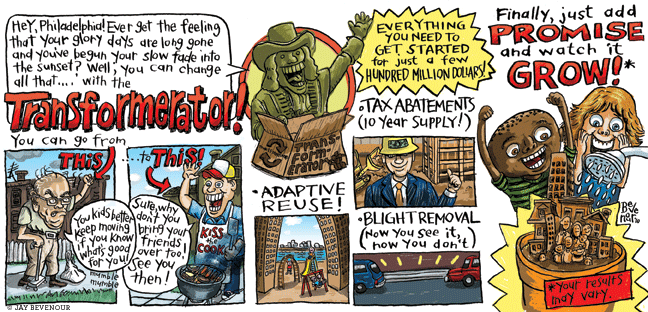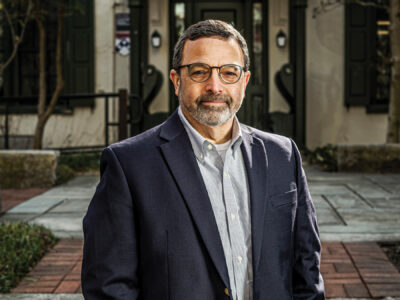
Two decades ago, Philadelphia embarked on an experiment that would ultimately transform it from a fading city whose glorious past seemed long gone into one with a strong present and a promising future. John Kromer, now a senior consultant at the Fels Institute of Government, was along for much of that ride as director of Philadelphia’s Office of Housing and Community Development from 1992 to 2000. In his new book, Fixing Broken Cities: The Implementation of Development Strategies (Routledge, 2010), he takes a look at a turbulent, but exhilarating, period in the city’s history and looks for lessons learned.
Pursuing several bold strategies at once—including a pioneering special-services district, and 10-year property tax abatements of unprecedented scope and generosity—Philadelphia achieved results that exceeded its original modest goals. The Center City District (CCD), as it was called, started with a simple priority: making downtown clean and safe. The property-tax abatement program initially aimed to encourage the conversion of vacant and underutilized buildings to their highest and best use, by freezing a property’s tax assessments at predevelopment levels for 10 years. Ultimately, CCD’s role expanded greatly, and the tax abatement expanded to cover new construction.
Both may have wound up benefitting a part of town that was less downtrodden than other neighborhoods to begin with, Kromer acknowledges, but they were signature projects for a city-on-the-rise. Center City’s population grew as it gained 3,200 residential units between 2000 and 2008. Major crime decreased by 39 percent in the downtown area between 1997 and 2008. And now Center City boasts a surfeit of quality-of-life goodies like some 200 outdoor cafes—up from zero in 1995.
Developers and property owners are often made out to be the primary beneficiaries of the abatement program. Two years ago ThePhiladelphia Inquirer reported that a “total of $256 million has been shaved off their tax bills.” Yet according to a model created that year by Kevin Gillen GrW’05, a Wharton School research fellow, an estimated two-thirds of all development in Philadelphia since 1997 (when the first abatement went into effect) wouldn’t have occurred without the abatements.
Now that the original abatement’s 10-year period is over, and the one for new construction is set to expire in 2012, many are calling for the discontinuation of the program, especially in light of the city’s ongoing budget crisis [“Gazetteer,” May|June 2009]. Mayor Michael Nutter W’79, however, has called abatements an “investment in the future” that have expanded the ranks of residents who pay wage, sales, and other taxes—including, ultimately, real estate tax.
As Philadelphia discovered, beleaguered post-industrial cities don’t have to start from scratch. “There are a number of strategies that Philadelphia used during the 1990s in its efforts at recovery,” says Kromer. “One was remaking the old Industrial Age infrastructure by removing blight and tearing down. That almost always has to happen—it’s just a question of degree.”
In the City of Brotherly Love, this manifested itself in then-Mayor John Street’s $300 million Neighborhood Transformation Initiative, which launched in the spring of 2001 and became the largest urban revitalization effort undertaken in America during the first decade of the 21st century. A practice run the previous year had successfully removed nearly 33,000 abandoned cars from city streets within five weeks; this time around the goal was to eliminate some 12,000 “imminently dangerous buildings,” as well as to acquire land and repair or modify homes for the disabled and elderly.
The project garnered negative reviews, Kromer notes, and was characterized as a poorly organized “hodgepodge of development ventures, public improvements, and public services that had relatively little impact.” Despite his own mixed evaluation of its success, he labels such severe verdicts “unfair,” adding that certain elements—such as the abandoned-car campaign and a program for the interim maintenance of vacant lots—were indeed “transformative.”
Kromer considers other ways in which a city might work with what it has. Adaptive reuse—such as development at Philadelphia’s Navy Yard that got under way as a result of the tax abatement program—is one strategy. There, old buildings are being repurposed as office spaces for creative businesses, and there’s even talk of connecting the area to Center City by way of a Broad Street subway extension (though the city would be hard-pressed to foot the estimated $400 million cost on its own).
The Center City District represents another approach: positioning a city to compete more effectively with what the suburbs can offer, starting with cleanliness and safety. Even though Business Improvement Districts had existed since the 1970s, Kromer says, CCD “did a really good job of getting buy-in from downtown’s major property owners of big office buildings.” And in keeping its own tax assessments separate from the city government’s collections, the CCD pursued a smart strategy, he adds. “The ability to do this at a time when confidence in the city’s governance was at a very low level was a very big plus.”
The CCD gradually took on projects like retail and restaurant promotions and streetscape and lighting improvements.
Kromer’s book devotes a chapter to the Penn Alexander K-8 school as a prime illustration of the private sector taking matters into its own hands. “Penn didn’t want a lab school or a charter school,” he says. “It wanted to create a universal benefit for the neighborhood. The idea that an academic institution would commit a substantial amount of its operating budget and administrative resources to get involved to this level in its community was very radical. But Penn was in a do-or-die situation and was very much threatened by the problems besieging the neighborhood.”
Penn Alexander was the culmination of the University’s more holistic approach to a variety of issues in West Philadelphia, Kromer points out. Other efforts included an incentive program to encourage its faculty and staff to buy homes in the area, and a realignment of its procurement policies to funnel more money into the neighborhood’s local businesses. (In 2003, Penn purchased $61.6 million in local goods and services, triple the amount from 1996.)
The influence of the Penn Alexander School in improving real estate values in University City was “undeniable,” writes Kromer. Houses within the catchment area sell for about $50,000 more than comparable homes outside the line, he reports. Yet as property values increased, so did concerns about affordability. If Penn had anticipated these better, Kromer suggests in his book, it might have considered two strategies to support affordable housing. One would be raising money to support a rental-assistance program (after convincing the city and state to put up matching funds; a big challenge, he concedes). The other would have been to explore the possibility of investing in apartment buildings located within the catchment area, and making sure that some of the units were available to families with below-median incomes.
Philadelphia, Kromer believes, is better positioned than most other cities to weather economic downturns, especially since it has a surfeit of developable land on its fringes. “During the coming years,” he writes in a new Fels report, Neighborhoods of Opportunity: Development Strategies for Success in a New Decade, “development ventures will need to be based on a new approach that emphasizes infill construction and housing preservation, more rental housing, and lower-cost development financing plans.”
Kromer points out that incentives like the tax abatement have benefited neighborhoods outside of the core, but he says that more needs to be done to encourage new affordable housing and rental units. He suggests updating the city’s vacant property inventory (the last one was completed in 2001); creating a program to finance the rehabilitation of vacant floors above storefront properties in Center City and on appropriate neighborhood retail corridors, for use as apartments; and supporting collaboration between Philadelphia’s housing agencies and job-training providers to address the housing needs of job-training program graduates.
“An exciting thing about the last two decades or so is that there have been many successful examples—not just in Philadelphia—of how to fix our cities,” Kromer says. “All of these tools just have to be used as a means of implementing a clear plan.”
—JoAnn Greco




